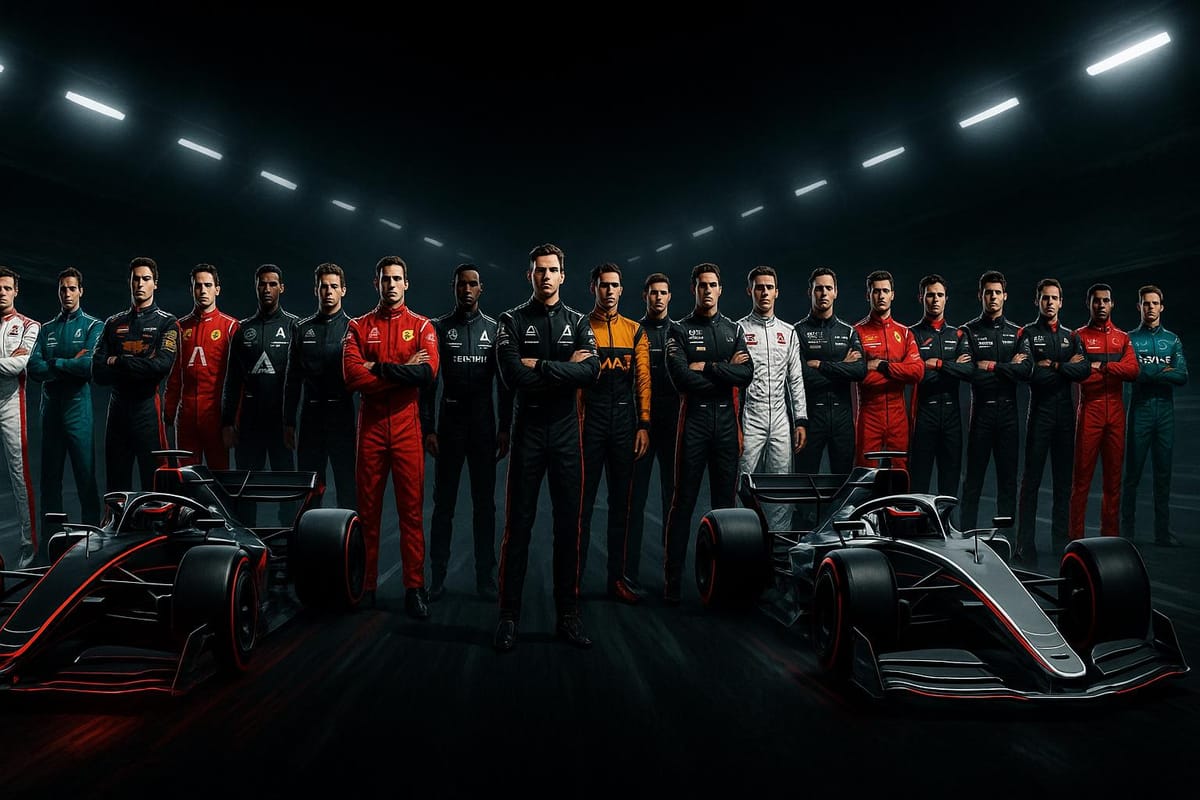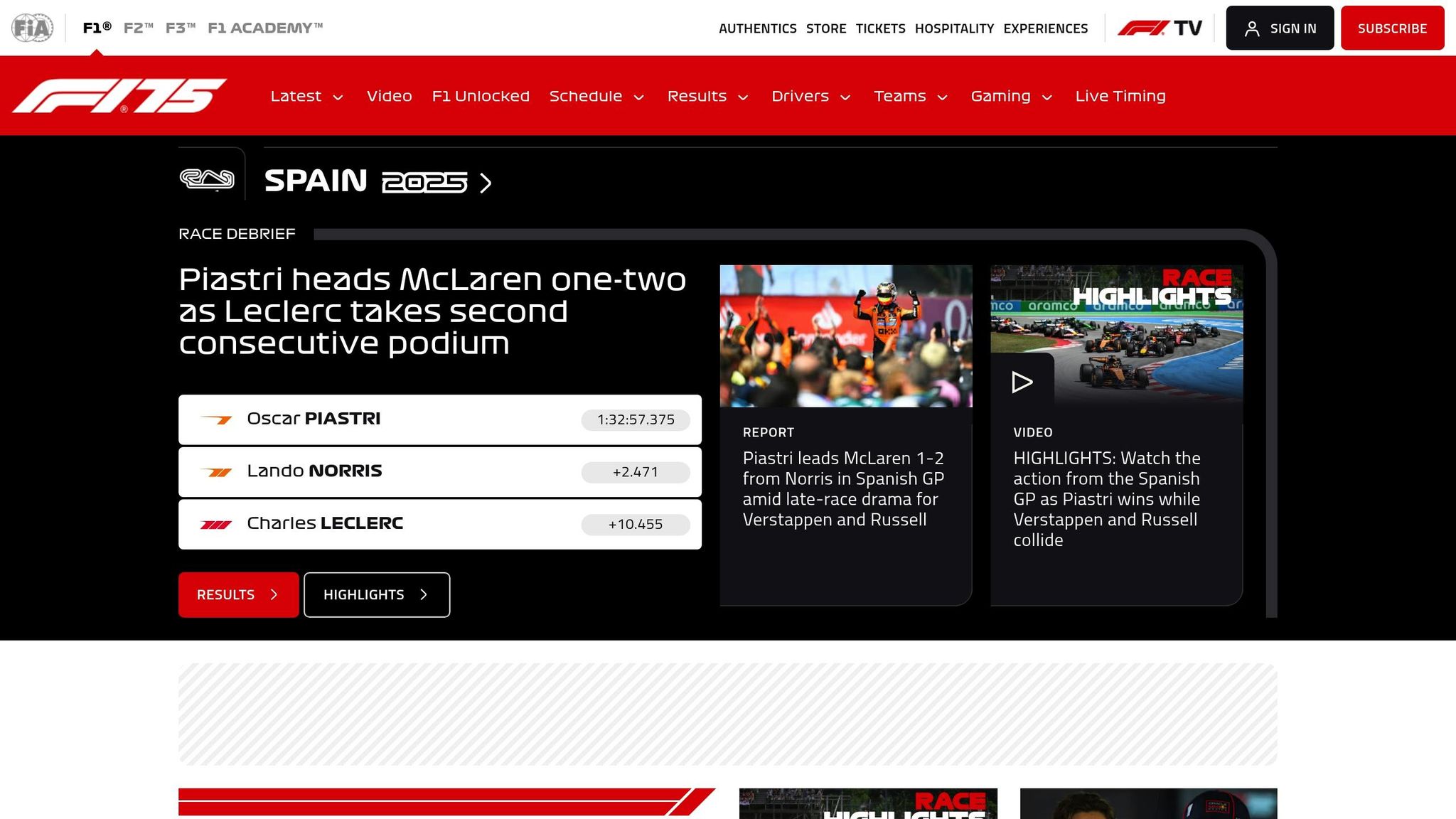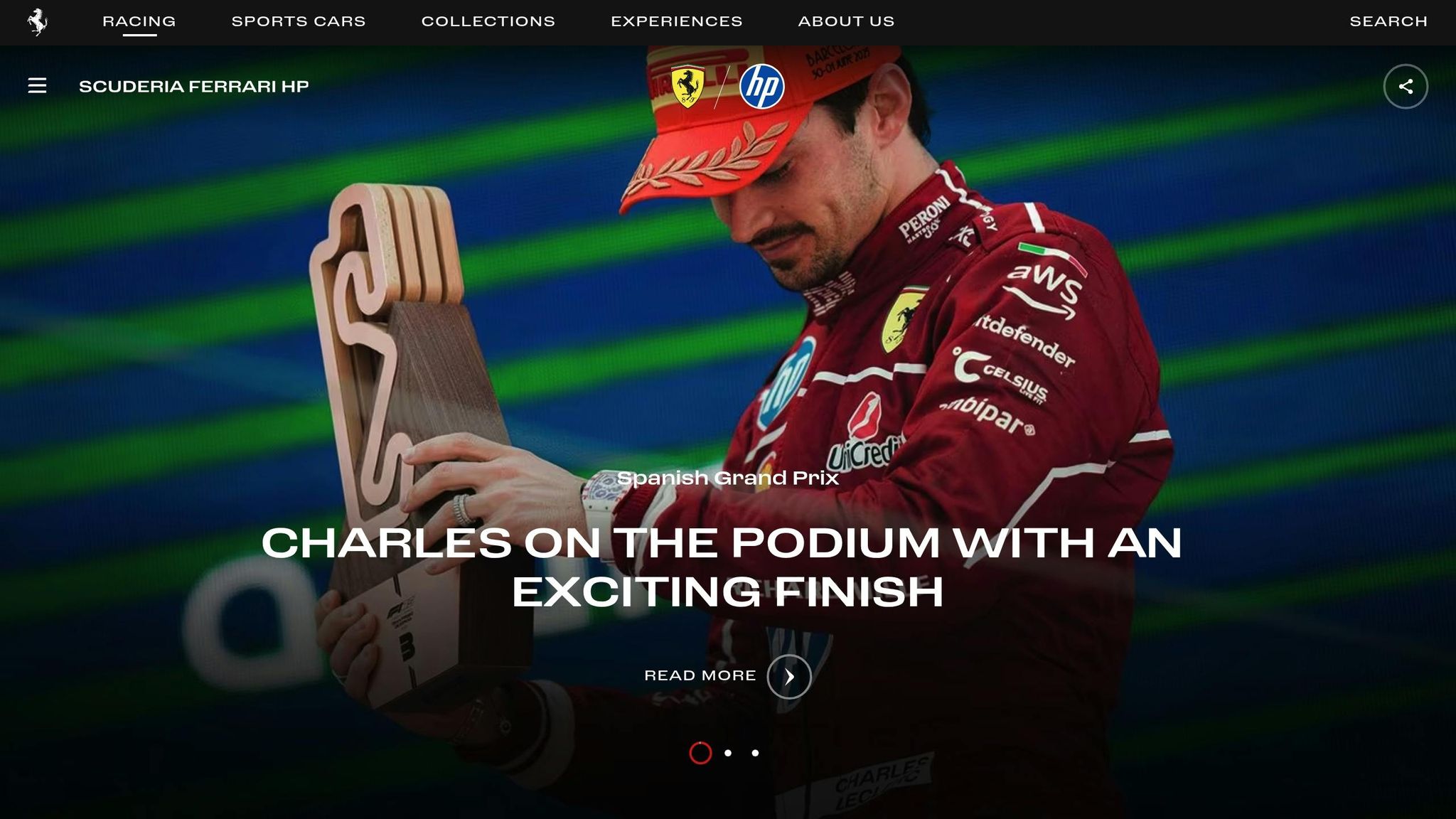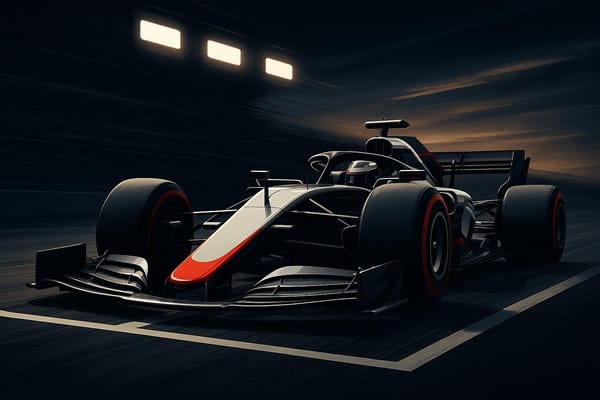Meet the 2025 F1 Grid: Profiles of Every Driver on the Starting Line
Explore the dynamic 2025 F1 grid with driver profiles, team changes, and the impact of new regulations shaping the season's thrilling competition.

The 2025 Formula 1 grid is packed with changes, fresh talent, and new rivalries. Here’s what you need to know:
- Biggest Driver Moves: Lewis Hamilton joins Ferrari to partner Charles Leclerc, ending his 12-year stint at Mercedes. Meanwhile, Mercedes promotes 18-year-old rookie Andrea Kimi Antonelli alongside George Russell. Yuki Tsunoda steps up to Red Bull, and Carlos Sainz moves to Williams.
- Rookies to Watch: Six rookies debut this season, including Andrea Kimi Antonelli (Mercedes), Gabriel Bortoleto (Sauber), and Oliver Bearman (Haas).
- Key Teams Keeping Stability: Only McLaren (Lando Norris and Oscar Piastri) and Aston Martin (Fernando Alonso and Lance Stroll) retain their 2024 lineups.
- 2025 Championship Leaders: McLaren drivers Oscar Piastri and Lando Norris lead the standings, with Max Verstappen close behind despite Red Bull's struggles.
- New Regulations: Stricter aerodynamic rules, simplified DRS systems, and mandatory driver cooling systems during high-heat conditions are shaking up car designs and strategies.
Quick Comparison: 2025 Driver Lineups
| Team | Driver 1 | Driver 2 | Notable Changes |
|---|---|---|---|
| Red Bull Racing | Max Verstappen | Yuki Tsunoda | Tsunoda replaces Sergio Pérez. |
| Mercedes | George Russell | Andrea Kimi Antonelli | Hamilton leaves; rookie Antonelli joins. |
| Ferrari | Charles Leclerc | Lewis Hamilton | Hamilton replaces Carlos Sainz. |
| McLaren | Lando Norris | Oscar Piastri | No changes. |
| Aston Martin | Fernando Alonso | Lance Stroll | No changes. |
| Williams | Carlos Sainz | Alex Albon | Sainz replaces Logan Sargeant. |
| Haas | Esteban Ocon | Oliver Bearman | Ocon and rookie Bearman join. |
| Sauber (Audi 2026) | Nico Hülkenberg | Gabriel Bortoleto | Rookie Bortoleto joins. |
| Alpine | Pierre Gasly | Franco Colapinto | Rookie Colapinto joins. |
| Racing Bulls (AlphaTauri) | Liam Lawson | Isack Hadjar | New driver pairing. |
The 2025 season is shaping up to be one of the most unpredictable in recent years, with fresh faces, bold team moves, and evolving strategies. Let’s dive deeper into what makes this year so exciting.
Meet The 2025 Formula 1 Drivers!

Team-by-Team Driver Profiles
The 2025 Formula 1 grid offers a compelling mix of seasoned champions, rising stars, and rookies eager to make their mark. Each driver lineup reflects strategic decisions aimed at balancing experience with potential, setting the stage for an exciting season. Here's a closer look at the driver pairings and what they bring to their respective teams.
Red Bull Racing

Max Verstappen remains the cornerstone of Red Bull's dominance, locked into a contract through 2028. With four world titles under his belt, Verstappen has consistently set the standard since 2017, never losing a head-to-head teammate battle. His presence alone makes Red Bull a perennial favorite.
Joining him is Yuki Tsunoda, who steps into a high-pressure role with the championship-winning team. Known for his raw speed and determination, Tsunoda faces the challenge of adapting to the demands of a top-tier team. How well he complements Verstappen will be pivotal to Red Bull's title defense strategy.
Mercedes

George Russell takes the reins at Mercedes following Lewis Hamilton's departure. His steady performances and sharp technical insights have positioned him as the team's natural leader, tasked with steering them into a new era.
Mercedes also makes a bold statement by promoting Andrea Kimi Antonelli, an 18-year-old rookie from their junior program. Skipping the traditional path to Formula 1, Antonelli enters the spotlight with immense expectations. Russell's ability to lead and Antonelli's capacity to adapt will define Mercedes' performance during this transitional phase.
Ferrari

Ferrari's 2025 lineup is one for the history books, pairing Charles Leclerc with Lewis Hamilton. Leclerc, now in his seventh season with the team, has established himself as a consistent frontrunner, combining raw speed with a deep understanding of Ferrari's ethos.
Hamilton's move to Ferrari is nothing short of monumental. The seven-time world champion brings a wealth of experience, a winning mindset, and unmatched technical expertise. His arrival has drawn comparisons to Tom Brady's late-career move to the Tampa Bay Buccaneers, symbolizing a quest for one last championship. Together, Leclerc and Hamilton create a dynamic mix of ambition and experience that could redefine Ferrari's future.
McLaren

McLaren sticks with its 2024 pairing of Lando Norris and Oscar Piastri, emphasizing stability. Norris has matured into a serious title contender, combining natural talent with polished racecraft. Meanwhile, Piastri's rapid development ensures a healthy intra-team rivalry, with both drivers pushing each other to new heights.
This pairing brings youthful energy and a collaborative spirit, key ingredients for McLaren's resurgence. However, balancing their individual ambitions will be critical to unlocking the team's full potential.
Remaining Teams Overview
- Aston Martin continues with Fernando Alonso and Lance Stroll, maintaining consistency. Alonso's vast experience and technical acumen remain invaluable as the team builds its partnership with Honda. While Stroll has struggled to match Alonso on track, his position is secure due to his family's ownership of the team.
- Williams fields a promising lineup with Carlos Sainz and Alex Albon. Sainz adds race-winning pedigree and a relentless work ethic to the team's rebuilding efforts, while Albon provides steady technical input and competitive performances.
- Haas blends experience with fresh talent by pairing Esteban Ocon with rookie Oliver Bearman. Ocon's reliability offers a stable foundation, while Bearman's youthful energy signals Haas' intent to shake things up and aim higher.
- Racing Bulls features Liam Lawson and Isack Hadjar, both eager to prove themselves. With points-scoring potential and aspirations for senior team promotions, their internal competition promises to be fierce.
- Alpine combines Pierre Gasly's proven competitiveness with Franco Colapinto, a rookie looking to secure his place in Formula 1. Gasly offers a solid base, while Colapinto faces the pressure of delivering results quickly.
- Sauber completes the grid with Nico Hülkenberg and Gabriel Bortoleto, the reigning Formula 2 champion. Hülkenberg's experience is crucial as Sauber transitions into Audi's factory team by 2026, while Bortoleto represents the next generation of talent, ready to make his mark.
Each team’s lineup reflects a blend of strategy, ambition, and adaptability, setting the stage for an unpredictable and thrilling 2025 season.
Technical and Strategy Trends in 2025
The 2025 Formula 1 season brings a wave of technical updates that are reshaping how teams approach car design and race strategies. With new regulations in place, teams are revising everything from aerodynamics to tire management, redefining the competitive landscape.
2025 Aerodynamic and Engine Rule Changes
The FIA has introduced stricter aerodynamic rules, focusing on limiting flexible wing designs that became a hot topic in 2024. Starting from the Spanish Grand Prix, front wing flexibility is measured under a 220-lb (100 kg) load. The vertical deflection must not exceed 0.39 inches (10 mm) when applied symmetrically or 0.59 inches (15 mm) when applied to one side. Additionally, the allowable deflection for front wing flaps has been reduced by 40%, from 0.20 inches (5 mm) under a 13-lb (6 kg) load to just 0.12 inches (3 mm).
"When championship battles become intense, teams tend to focus on each other's cars a lot, and naturally they raise concerns and over the latter half of the season we came to the conclusion that we needed to strengthen the tests for 2025", said Nikolas Tombazis, FIA Single Seater Director.
Rear wing regulations have also tightened. The mainplane can now flex no more than 0.24 inches (6 mm) under load, while the upper flap is limited to 0.28 inches (7 mm). The trailing edge's flexibility is capped at 0.12 inches (3 mm), and the slot gap between wing elements has been reduced to a range of 0.37–0.51 inches (9.4–13 mm), down from 0.39–0.59 inches (10–15 mm).
The DRS system has also been simplified to just two positions - closed and open - with a transition time of under 400 milliseconds. This change addresses the "mini-DRS effect" that stirred debate last season.
Weight regulations have shifted as well. The minimum car weight has increased to 1,764 pounds (800 kg), partly due to a 4.4-pound (2 kg) rise in minimum driver weight. Additionally, during "heat hazard" conditions - declared when temperatures reach 88°F (31°C) - an extra 11 pounds (5 kg) is added for mandatory driver cooling systems.
New Tire Strategies
Tire strategies are also evolving, adding another layer of complexity to race planning. Pirelli has introduced the C6 compound, their softest tire yet, which encourages teams to adopt more aggressive approaches. Tracks like Imola and Monaco have shown that the C6 offers exceptional grip during flying laps, but it also demands precise management.
Monaco, in particular, now mandates a two-stop strategy, a first since 1985. Drivers are required to use three different tire compounds during the race - a move designed to increase unpredictability and on-track drama.
"Teams always find a way to apply a strategy on one stop. We are trying to push them to have a two-stop strategy because it's better, it's more action, more unpredictability, and better races", explained Mario Isola, Pirelli Motorsport Boss.
Pirelli is also experimenting with "compound skipping" at select races, using combinations like C2, C4, and C6 to create more pronounced performance differences between tires. Meanwhile, advancements in data analytics and simulations are helping teams better predict tire wear and optimize pit-stop timing. The efficient tire strategies seen at the 2024 Italian Grand Prix highlight the growing importance of these tools.
"Collecting the information for the C6 in Monaco was not really significant. Monaco is a particular circuit... For us it's really important to collect data here [Imola] for the C6, also for the selection for the second part of the season", noted Simone Berra, Pirelli Chief Engineer.
Team Development Focus Areas
Teams are focusing on several key areas to stay competitive under the new rules. Aerodynamic adjustments are a top priority, especially with stricter limits on front wing flexibility. Engineers are relying heavily on wind tunnel testing to refine designs that maximize downforce within the tighter constraints.
Driver cooling systems have also become a critical focus. With mandatory cooling equipment required during heat hazards, teams are working to develop lightweight yet efficient solutions. The added weight penalties make this a balancing act between performance and safety.
The updated DRS regulations are pushing teams to re-engineer actuator systems and wing designs to ensure seamless transitions within the 400-millisecond limit. Additionally, the increased minimum car weight means every extra pound must be carefully allocated to maintain optimal balance, a challenge compounded by the heavier driver weights and cooling systems.
Looking ahead, teams are already testing mule cars for the 2026 tire regulations, balancing current-season performance with long-term planning. This dual focus is reshaping how resources and strategies are managed across the grid.
With these technical updates and strategic shifts, the 2025 season is poised to deliver an exciting and dynamic competition. Teams will need to innovate and adapt quickly to stay ahead in this evolving landscape.
Driver Rivalries and Championship Predictions
The 2025 Formula 1 season is heating up with intense driver rivalries. New team pairings and rising stars are stirring up competition, both within teams and across the championship. With the grid more evenly matched than ever, these rivalries are shaping race results and the overall standings.
Top Intra-Team Battles
Ferrari has seen Charles Leclerc outpace Lewis Hamilton in full races, leading 4–0, though Hamilton claimed victory in their only sprint race. Reflecting on the challenge of competing alongside Hamilton, Leclerc shared:
"It will be both extremely interesting for me to learn from one of the best ever, as well as a really big challenge and motivation to beat Lewis and to show what I'm capable of".
At Mercedes, George Russell is dominating rookie Kimi Antonelli, with a 5–0 record in full races and a 1–0 edge in sprints. Antonelli’s early struggles highlight the steep learning curve for newcomers in Formula 1.
Meanwhile, at Williams, Alex Albon has established himself as the team leader, leading Carlos Sainz 4–1 in full races and also winning their sprint. Williams Team Principal James Vowles emphasized Albon’s role:
"I needed a leader, not just someone who is quick in the car".
These intra-team battles are adding an extra layer of drama to an already thrilling season.
Championship Contenders
The championship race is as tight as ever, with Oscar Piastri leading the standings as of May 30, 2025. He has amassed 186 points, closely followed by McLaren teammate Lando Norris with 176 points, while Max Verstappen holds third place with 137 points. Piastri’s early-season form has been remarkable, with 3 wins in the first 5 races, podium finishes in 7 of 8 races, and a 3–2 race win advantage over Norris.
Norris, however, remains a strong contender, having won the Australian Grand Prix and matching Piastri’s 7 podium finishes. Max Verstappen, though slightly behind in points, continues to impress despite Red Bull’s struggles this season. As Sports Illustrated’s Zach Koons observed:
"what the four-time reigning champion has been able to muster out of this year's lackluster Red Bull is yet another testament to his ability".
The championship odds reflect the fierce competition at the top:
| Driver | Team / Constructor | Points | Championship Odds |
|---|---|---|---|
| Oscar Piastri | McLaren | 186 | 11/8 |
| Lando Norris | McLaren | 176 | 13/8 |
| Max Verstappen | Red Bull Racing | 137 | 5/1 |
| George Russell | Mercedes | 99 | 100/1 |
| Charles Leclerc | Ferrari | 79 | 150/1 |
| Lewis Hamilton | Ferrari | 63 | 200/1 |
These odds highlight the pivotal role each driver plays in their team’s 2025 aspirations.
Midfield and Rookie Performers
The midfield battle has also offered plenty of excitement. Fernando Alonso continues to showcase his exceptional skills at Aston Martin, maintaining his dominance over teammate Lance Stroll. These midfield rivalries add depth to the grid, with every position fiercely contested. Autosport’s Alex Kalinauckas described the dynamic:
"Beating your team-mate is the number one job for any racer, but in F1 this year the close fighting adds an extra edge, as any underperformance will leave a team exposed".
Former F1 driver Johnny Herbert also weighed in, noting the high stakes and competitive nature of the season:
"It is really exciting. People need to be there to see the start of the season next year. It's going to be one helluva fight the whole year between four teams. Oscar will be very difficult to beat but Lando has upped his game when he has had to and has been the man who has effectively led the team to be where it is at the moment".
As new talent rises and traditional powerhouses adapt, these rivalries are redefining the championship narrative. The stage is set for one of the most unpredictable seasons in recent memory.
2025 F1 Season Preparation Guide
The 2025 F1 season is shaping up to be a thrilling mix of fresh talent, new regulations, and shifting team dynamics. With six drivers making their full-time debuts and significant changes to car rules, the grid is entering a period of transformation and uncertainty.
McLaren enters the season as the team to watch, thanks to a strong showing in pre-season testing. However, their success hinges on Oscar Piastri closing the performance gap with teammate Lando Norris, a challenge that could determine their championship prospects.
Over at Ferrari, the pairing of Charles Leclerc and Lewis Hamilton has sparked intrigue. Leclerc’s raw speed in qualifying combined with Hamilton’s mastery of tire strategy creates a fascinating tactical dynamic. Their ability to sync quickly will be crucial for Ferrari's success.
The new aerodynamic regulations are another major factor, pushing teams like Red Bull and Williams to redesign their wings for greater stiffness and stability. These adjustments aim to enhance overtaking capabilities, setting the stage for bold moves on the track. Early pre-season testing has already offered a glimpse into how teams are adapting to these changes.
Pre-Season Testing Insights
Pre-season testing data has highlighted some key trends and potential challenges for the teams:
- Mercedes completed an impressive 458 laps, focusing on reliability and positioning themselves as one of the most prepared teams on the grid.
- Red Bull, on the other hand, managed only 304 laps, grappling with early technical hiccups that could signal a rocky start.
- McLaren struck a balance with 381 laps, showcasing their readiness as defending champions.
| Team | Testing Laps | Distance (Miles) | Key Insight |
|---|---|---|---|
| Mercedes | 458 | 1,540 | Reliability focus, most prepared |
| Red Bull | 304 | 1,022 | Technical issues, potential struggles |
| McLaren | 381 | 1,281 | Balanced approach, defending champions |
Rookie Drivers and Team Dynamics
Rookie integration will be a defining theme this season. Drivers like Kimi Antonelli face a steep learning curve as they step into the spotlight, contrasting with seasoned competitors such as George Russell. Teams must strike a delicate balance between nurturing new talent and delivering immediate results, a challenge that adds another layer of complexity to the season.
Meanwhile, evolving strategies are reshaping the way teams approach races. Adjustments to pit stops, tire management, and car setups are being fine-tuned to handle the altered handling characteristics brought about by the new regulations. Teams like Mercedes and McLaren, which are leveraging advanced telemetry and AI for real-time decision-making, may gain an edge in this tech-driven era.
As fans and analysts gear up for the season, the key areas to watch will be how drivers adapt to the rule changes, how intra-team rivalries influence strategy, and whether reliability trends from testing carry over into race weekends. With so many variables at play, the 2025 grid promises to shake up traditional hierarchies, keeping everyone guessing as the season unfolds.
FAQs
How will Lewis Hamilton joining Ferrari in 2025 affect the team and his partnership with Charles Leclerc?
Lewis Hamilton's upcoming move to Ferrari in 2025 brings a mix of promise and potential hurdles for the iconic team. With his wealth of experience and championship-winning track record, Hamilton has the ability to push Ferrari's performance to new heights. His arrival could also ease some of the burden on Charles Leclerc, giving both drivers the space to concentrate on delivering top-tier results.
That said, having two elite drivers under the same roof isn't without its challenges. Internal competition could become a factor. While early signs suggest Hamilton and Leclerc are fostering a positive working relationship, managing their individual ambitions will be critical. How Ferrari navigates this dynamic will likely play a pivotal role in determining their success in the 2025 season.
What challenges do rookies Andrea Kimi Antonelli and Gabriel Bortoleto face in their first F1 season?
Rookies Andrea Kimi Antonelli and Gabriel Bortoleto are gearing up for a challenging debut on the 2025 Formula 1 grid. Antonelli, driving for Mercedes, is not only navigating the intense world of F1 but also balancing his academic commitments, including exam preparation. This dual responsibility puts added pressure on his schedule, making effective time management a key challenge during race weekends.
On the other hand, Bortoleto, fresh off a successful Formula 2 championship, is now representing Sauber. He’s facing a different set of hurdles as he transitions to a slower car and goes head-to-head with experienced F1 drivers. The adjustment demands patience and a steep learning curve as he works to establish himself in the sport. Both drivers are prime examples of the mental and physical resilience required to thrive as rookies in the high-stakes world of Formula 1.
How will the new 2025 aerodynamic and tire rules impact team strategies and race results?
2025 Formula One Season: Key Regulation Changes
The 2025 Formula One season is bringing some big shifts with updates to aerodynamic and tire regulations, and these changes are poised to shake up team strategies and race dynamics. One of the most notable adjustments is the stricter limit on front wing flexibility. The allowable flex has been cut down from 15mm to 10mm, meaning teams will need to rethink their car setups. This could be a game-changer, especially for teams that have leaned heavily on creative wing designs to gain an edge. With this restriction in place, the focus might shift more toward driver skill and strategic decisions, potentially narrowing the gap between teams.
Another major update is the new tire rule for the Monaco Grand Prix. Teams will now be required to use three different tire sets during the race. The goal? To increase pit stops and open up more chances for strategic overtakes. This adds a fresh layer of complexity to race planning, as teams will need to carefully manage tire wear, performance, and pit timing to stay competitive. These changes are all about creating tighter competition and making the races more action-packed for fans.




